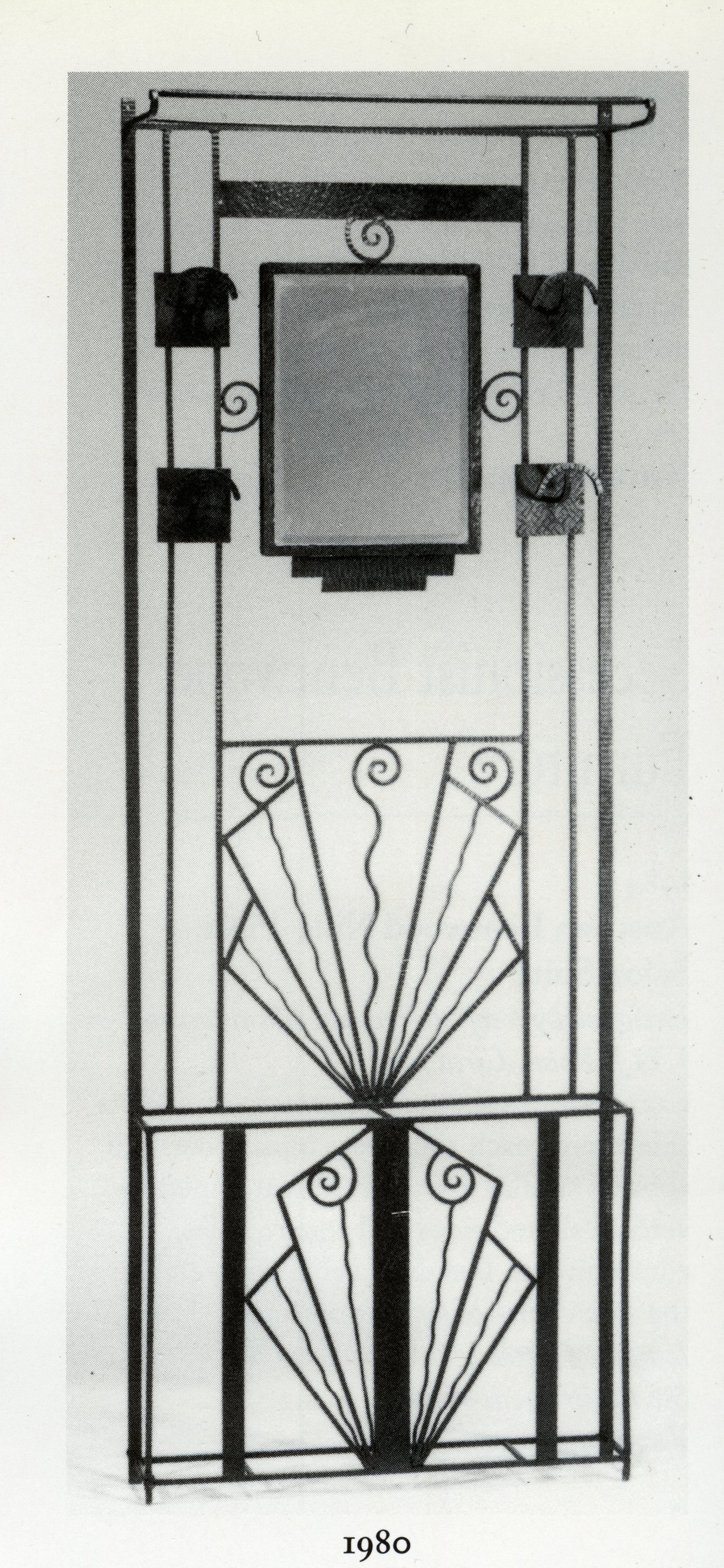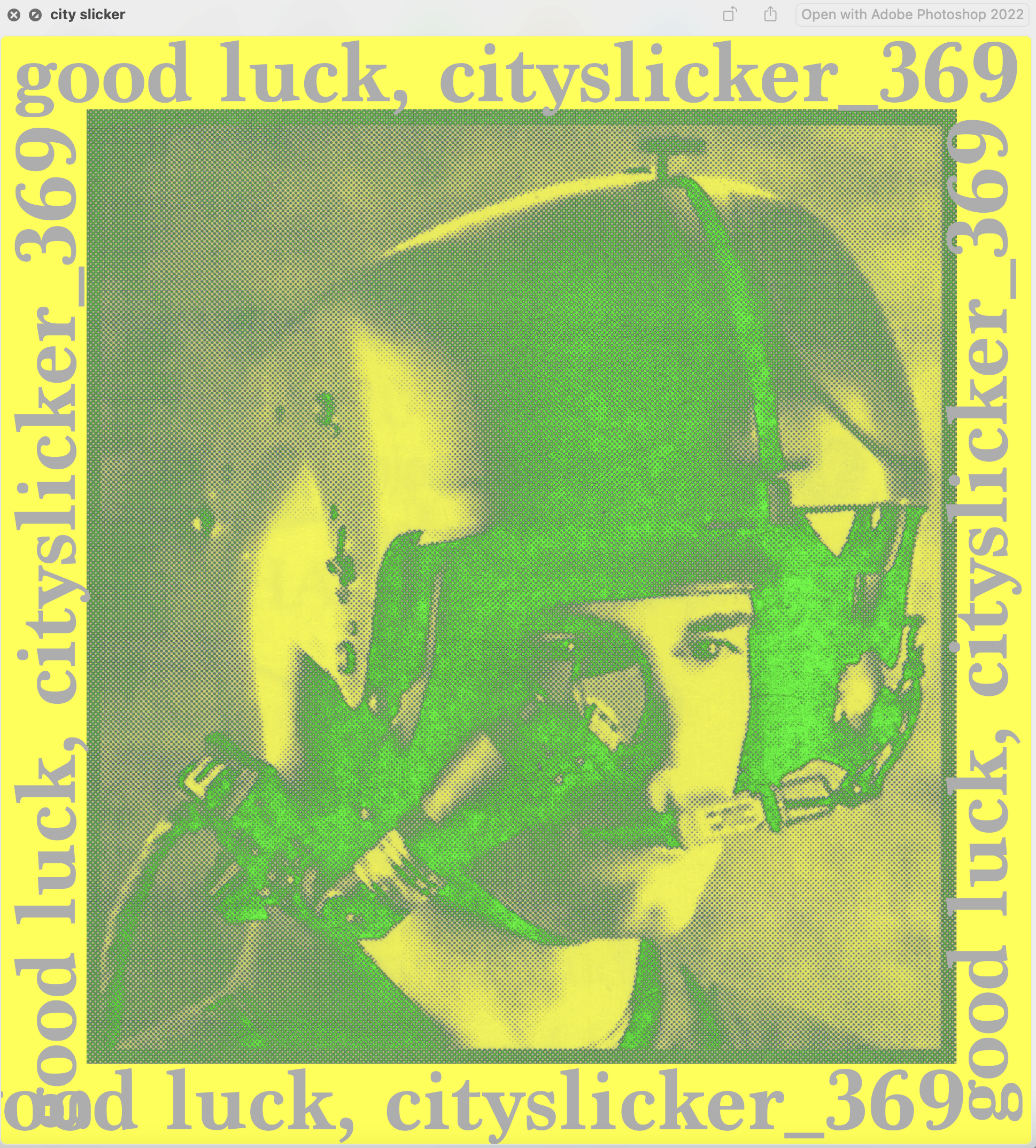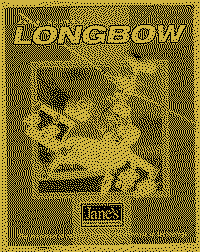20/10/22. C41 hand printing tests (A starting strategy, a new building of images)
Beginning to make tests in the colour darkroom, re-familiarising myself with the C41 process. Here I am working on colour grading and meditating on ideas of sequencing and the multiple.
Printing with a contact frame rather than an easel I am allowing for a certain displacement with each multiple, often printing 6-10 iterations of the same image. This is method which provokes subtly imperfect alignment and makes room for potential cropping errors/ differences throughout the sequence. Each iteration of the same image is altered - even if it is just in a few millimetres of crop difference. Minimal scratches interrupt the projection & trapped dust remains between the glass surface of the frame and the photographic paper. At this stage I do not necessarily intend to make such elements obvious/ central factors of my work, but I do intend to leave this door open and allow space for the remanence of analogue process. In a similar way I have made subtle tests with multiple exposures.
Inconsistencies and character are what attract me to certain methods of working, and in this process, I am interested in the intuitive method and allegory of working in the dark. Conscious of the numerology of the tarot as I am printing, multiples and cycles of completion are not necessarily with the intention of being presented as such, but at this stage it is an intuitive method of gathering material which may have future potential for working with. I am not concerned with making identical editions, but rather with allowing for movement and play/ openness to direction.
Imagery I have started to work with in these printing tests consist of recent sculptural studies which have themselves been made in multiple photographic iterations. The windmill/ scarecrow structure to me is like a primitive sub-station, a converter of energy coupled with an intention to ward off. Harnessing the very wind that birds glide in as weapon against them can be read as political, in the same way that a selection of objects atop a bedside table can be read as an inventory of a state of mind.
![Assembly tests with Oracle cards, children's toys & assorted bits of Plastic and Metal]()
![Assembly tests with Oracle cards, children's toys & assorted bits of Plastic and Metal]()
![Assembly tests with Oracle cards, children's toys & assorted bits of Plastic and Metal]()
01/11/22’ Ophelia Screen-print, polarising forces, Immediacy, Christian Art, American Folk Art.
A few weeks ago, I found a large board being thrown out during a pub renovation in Piccadilly. Being of the sort of size and proportion I have been looking for (120 x 105cm), I brought it back to Camberwell on a bus and painted over it with standard trade white wall paint so that it was ready to use for something. There seems to be a period of time necessary - when using found materials - to let the material sit in the space. Rarely am I able to make use of it right away, but its purpose sort of unfurls over time.
Recently I started re-viewing some of the colour darkroom prints that I made in October and made some quick visual tests on the board (print layouts/ collages etc). At this time, I was also scanning in some found imagery of crime scenes and I ended up blowing up a large image of a burned corpse of a gold prospector, sort of nudged by my placement of 5 print variations of an unlit fire on the board. That is not to say this was a direct reaction to the symbol of fire, but more a natural coming together of elements. I have just had this image printed on 2 large acetate sheets as a loose positive/ negative (allowing for gaps of underpainting to show through) - these are each being exposed to a screen and will be used to produce a 2 layered print in silver and black - covering the board and partially overlaying the prints.
These C-prints are made from 2 different negatives… each varying subtly in terms of both camera angle and colouring. There is a bit of packaging in the arrangement with text visible in 2 of the images, and as the angle changes this disappears. You can also notice subtle changes in the arrangement of the 3 sticks coming into the foreground. The left-most print is partially covered by the print to its right, and also bares the mark of a printing burn which darkens the left hand side of the image to a deep orange/ red.
Laying at the bottom of the board, the placement of the prints subtly mimics the kind of panelling found in early Christian/ Byzantine murals as well as compositions found in American Folk Art, such as in the work of William Hawkins, and George Widener. There is something about this tiling, or panelling that transmits a story, a certain layout of information which denotes the progression or regression of one element to the next, or otherwise defines characters and becomes an act of phrasing. Thinking of the catholic triptych for example (often painted in the early Byzantine style / egg tempura), the separate outward folding panels are used to define alternate spaces, while remaining joined as one total piece. This can be seen in devotional depictions of the Madonna, where we can see her positioned in a different scenario on each of the 3 panels. In such depictions the Madonna is thus built of many aspects, a whole personality is generated in the metaphysical (from the position of the painting itself) combination of the 3 aspects of the triptych.
The figure/ gold prospector (to be screen-printed on this board) lies in the position of John Everett Millais’ Ophelia (1851-1852). An image of the realm of the sword (intellectual information/ found photograph) is superimposed onto the grounded/ empirical ‘fabric of reality’ (pentacles) which here is the first hand, self-created image of the unlit fire. This temporal/ non-temporal space (of the ground) carries a certain personal weight of experience, the unlit fire was photographed on a farm I was living/ working at on the French/ Spanish border and is now part of a collection of photographs that represent a past life for me. In contrast, I observe a detached relationship to the found photograph. Although of a potentially morbid quality, I view this corpse as a material symbol of life and death and metamorphosis, in other words to take it at face value for its material qualities. There is a detachment here and an attachment there that provokes different usages / working methods, and I find inspiration between these elements.
The fictional Ophelia figure can be seen to represent all material encountered on the intellectual plane (Cups/ Swords/ of the heavens). The unlit fire conversely, the Empirical plane (Pentacles/ Wands/ terrestrial). Within this context of dividing between the heavens and earth, the unlit fire exists in the same dimension as Millais on-location landscape, when said painting is understood as a composite made between (1st) location and (2nd) studio.
I keep writing and then deleting phrases like ‘neither are connected to reality’ because they are a painting or a photograph, but they both are reality. To deny this is to create a hierarchy between the reality of the world as a natural organism of governing forces and the world of human experience. In this context nature becomes ethereal and otherworldly and man becomes an alien. We make statements that a landscape walked through is reality and a painting or photograph is a copy, the question to ask in this case is: who is it that is walking through this landscape? Because to know something is to know it from our-selves, and to project onto the realities outside of our-selves is to assume.
A tree does not ‘whisper in the wind’ a mountain doesn’t cry. Physics remains a tool to contemplate the reality of the physical world outside of our-selves (Pentacles/ Wands), and art and spirituality the reality of ourselves - which in turn generates the non-physical aspects of the shared world/ consciousness (Cups/ Swords). That is to mark a distinction between oneself and a tree as two separate things, but not to perpetuate a hierarchy of reality. Humans are posed as pieces on an ancient chess board, what is interesting is that once cavemen, we now regard ourselves as intellectual beings somehow separated from nature by our ‘intelligence’. We want to be able to grasp that reality outside of ourselves because that is god, but it seems that it could be our enforced separation of the inner and the outer that holds us in our black and white squares.
The conflict I feel which I can see to be present in this piece as it evolves, is perhaps within immediacy. Where I have found communication or inspiration in the empirical act of photographing things/ looking through the eye of the camera… I now find communication in images that come to me already in image form. I find that images require an input of time and travel, alteration and disharmony (division/ multiplication) in order for me to feel able to produce an expression, and photographs that I take remain for years at the very start of that journey. With found/ circulated images this process is already well established - and so I feel a lot of creative potential in performing the role of catalyst between these new and old forms.
On my processes of information gathering, sometimes the intellectual world feels more immediate, and sometimes the empirical world does. It is the information gathering that is important in-itself and the exploration of differences without enforcing hierarchy between forms of information (fiction/ non-fiction). When I was living in the Pyrenees, a field of Iris’ could send me a divine message, Living In a city it is a broken hair dryer at a car-boot. My practice, through works like this is focusing on listening to these communications… on gathering materials and creating spaces where they may or may not come together.
![A.I variation of one of my small drawings (print test, using upscaling software)]()
![A.I variation of one of my small drawings]()
![Generation 2]()
![dall-e-2. A.I generation 1]()
![Generation 3]()
29/11/22’ Learning to use the CNC with George and how to produce simple vector drawings to instruct the router.
There are various cutters one can use and lots of possibilities in terms of depth, but to start the act of tracing a photograph to produce a simple line drawing was inspiring. Again, there is an act of translation at play, or variant making which interests me. I start with a photograph from an auction catalogue which is a translation, so now we are bypassing the actual object itself and, in this context, it becomes almost redundant.
I copy the image, tracing it with a series of line and box tools in illustrator (There are two basic modes of cutting which are lines and pockets, a line is cut with the width of the selected router head and a pocket cuts out all the space between connected lines, used for cutting areas larger than the router head). As I go through this process, I simplify some elements, the photograph now being translated into a series of 2D lines. Once this is done adjustments are made for depth, router passes etc., and the instructions are input to the router.
From a photograph the symbol is now manifest in wood, as it is routed it becomes part of the tactile world, adorned with physical coat hooks and now becoming an object capable of hanging clothes. There is an interesting cycle at play here from photograph to drawing and into material form. It is like a sort of backwards birth in which we end up with an object that seems to sit between dimensions. Naming it logically as an ‘Art Deco Wrought iron hall tree’ It gives me the same impression as an A.I variation... it is what it says it is, but it also is not.
03/12/22’ Knitting machines and img2track.
I have been to some workshops on knitting machines and img2track software in the Camberwell Graphic design space. I have learned that code for knitting machines was essentially the birth of binary, and that this is what the first computers where used for.
There are a lot of interesting projects which pay homage to this connection between knitting and computer technology, with a lot of artists making interesting generative works in which conversions and translations take place - from recording the motion of the sea, to translating musical scores. In a similar way to using an analogue camera or the CNC router, I find that I am inspired to use methods of translation. It is the act of translating from one form to another... producing a variation which excites me. It reminds me of when I first started to use photoshop in college and I spent hours applying all the pre-set filters to images until nothing was left and my images resembled more a digital glitch or abstract painting than a photograph.
I have been inducted onto the machine and plan on making more experiments with this in the future (most likely in Unit 2). There is something brilliantly simple about these conversions that can take place, or more it is the ability to simplify vast movements such as a musical score, into a list of 1’s and 0’s.
I have made designs for an initial hanging which could be caught in the same sort of space that 80’s Sci-fi novels are today... something like future nostalgia. the idea is for a commemorative hanging of a stylised retro-futurist soldier going off to war... his costumed portrait in the centre, bordered with best wishes and his name which is a gamer tag. I have spoken with a textile designer friend in New York who will collaborate with me on this project to incorporate different knitting techniques. The idea is that I produce the centre portrait using img2track and 90’s video game imagery, while she uses a manual jacquard technique to produce and LCD screen inspired wrapping text border. The two elements will be hand sewn together.
Beginning to make tests in the colour darkroom, re-familiarising myself with the C41 process. Here I am working on colour grading and meditating on ideas of sequencing and the multiple.
Printing with a contact frame rather than an easel I am allowing for a certain displacement with each multiple, often printing 6-10 iterations of the same image. This is method which provokes subtly imperfect alignment and makes room for potential cropping errors/ differences throughout the sequence. Each iteration of the same image is altered - even if it is just in a few millimetres of crop difference. Minimal scratches interrupt the projection & trapped dust remains between the glass surface of the frame and the photographic paper. At this stage I do not necessarily intend to make such elements obvious/ central factors of my work, but I do intend to leave this door open and allow space for the remanence of analogue process. In a similar way I have made subtle tests with multiple exposures.
Inconsistencies and character are what attract me to certain methods of working, and in this process, I am interested in the intuitive method and allegory of working in the dark. Conscious of the numerology of the tarot as I am printing, multiples and cycles of completion are not necessarily with the intention of being presented as such, but at this stage it is an intuitive method of gathering material which may have future potential for working with. I am not concerned with making identical editions, but rather with allowing for movement and play/ openness to direction.
Imagery I have started to work with in these printing tests consist of recent sculptural studies which have themselves been made in multiple photographic iterations. The windmill/ scarecrow structure to me is like a primitive sub-station, a converter of energy coupled with an intention to ward off. Harnessing the very wind that birds glide in as weapon against them can be read as political, in the same way that a selection of objects atop a bedside table can be read as an inventory of a state of mind.
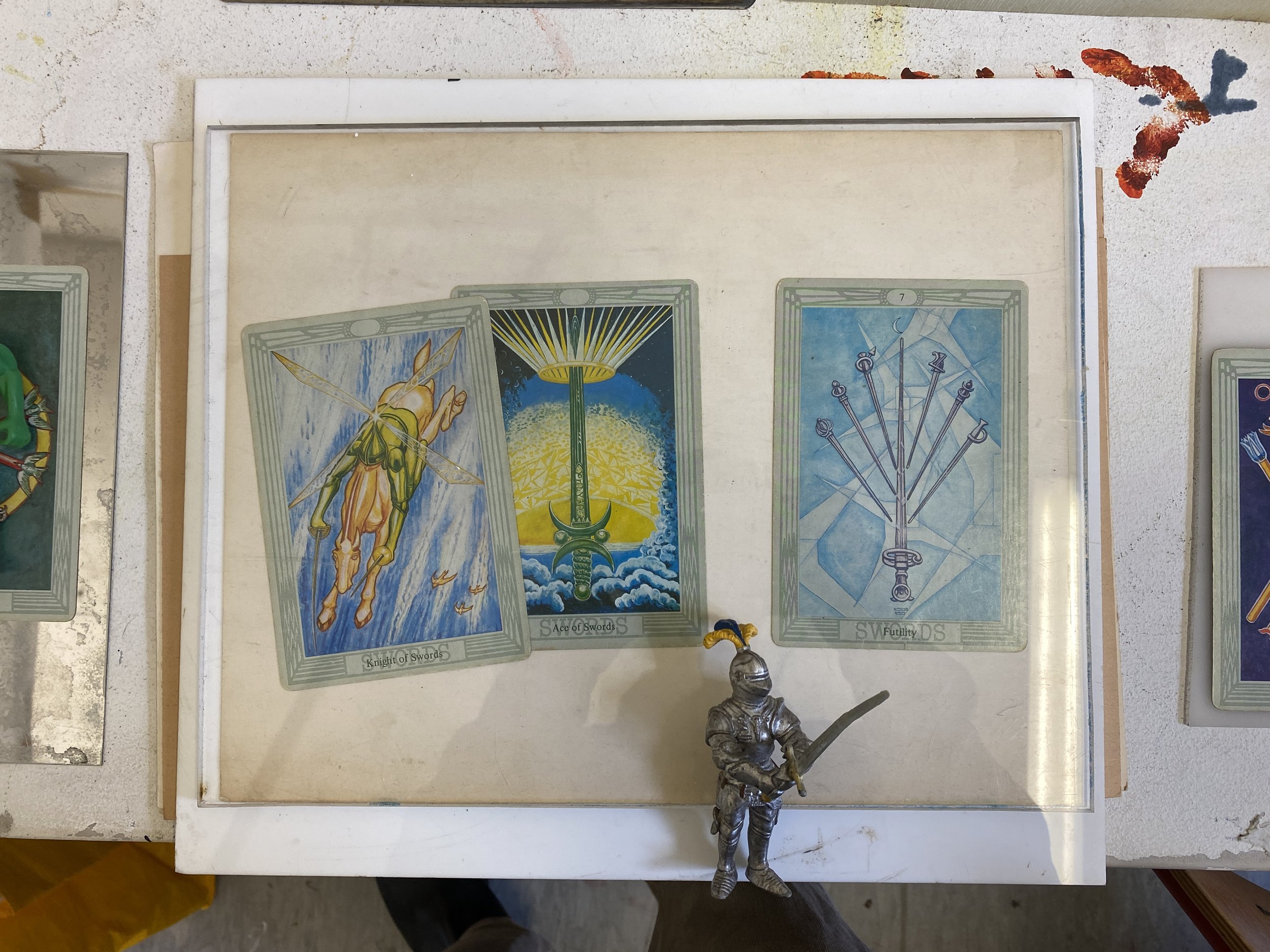
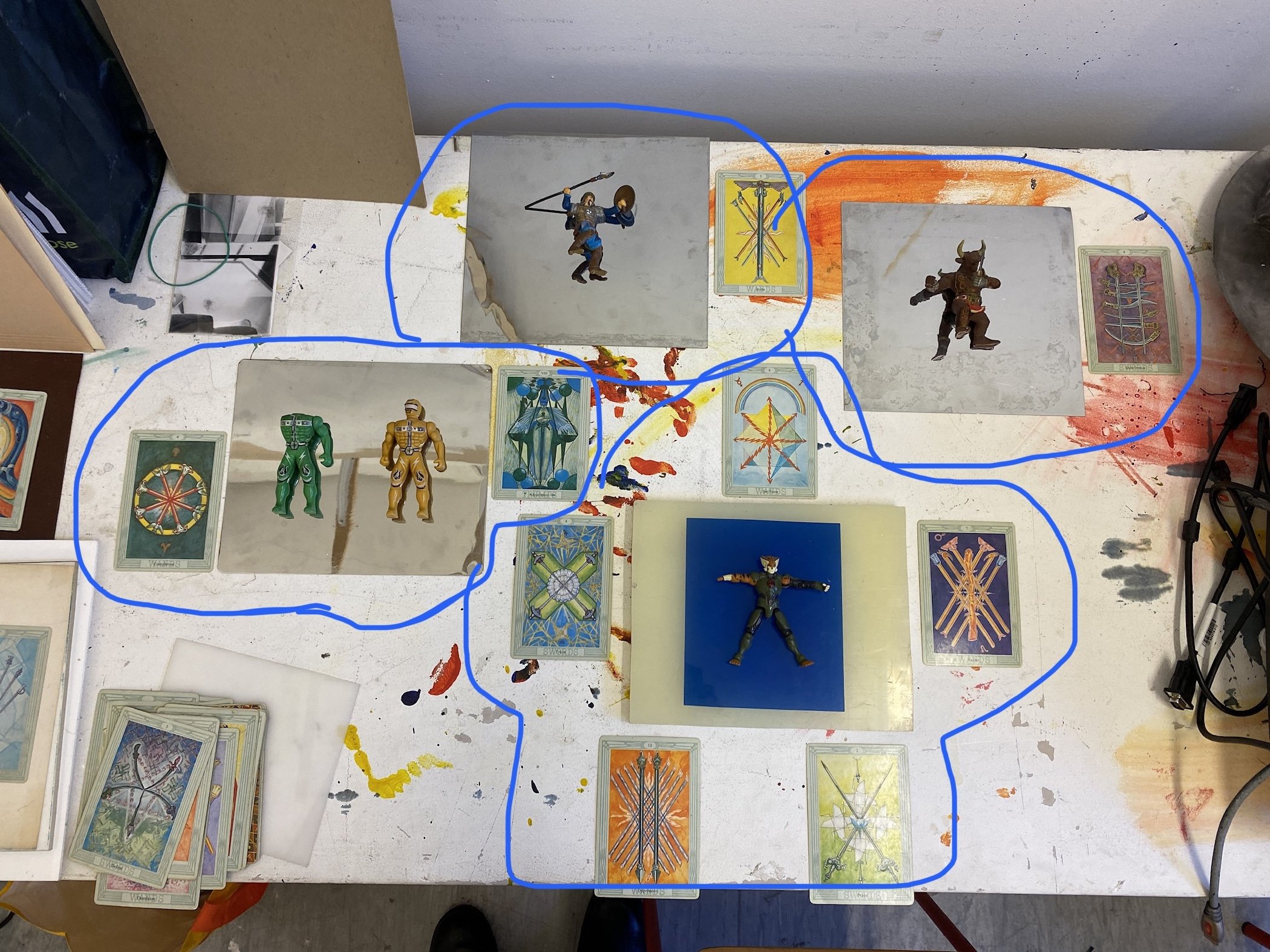
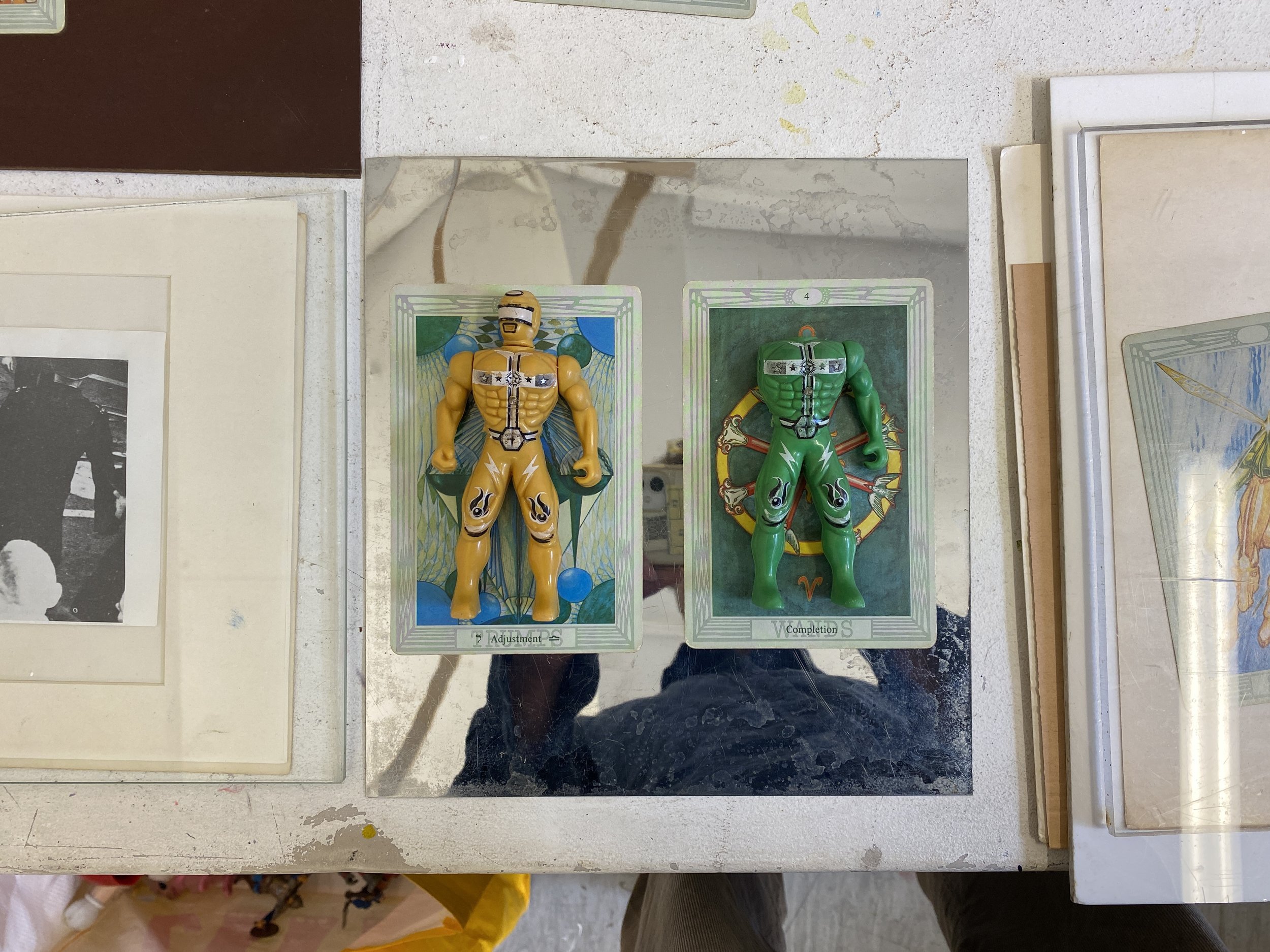
(KEY EVENT 1) ‘Information gathering’
01/11/22’ Ophelia Screen-print, polarising forces, Immediacy, Christian Art, American Folk Art.
A few weeks ago, I found a large board being thrown out during a pub renovation in Piccadilly. Being of the sort of size and proportion I have been looking for (120 x 105cm), I brought it back to Camberwell on a bus and painted over it with standard trade white wall paint so that it was ready to use for something. There seems to be a period of time necessary - when using found materials - to let the material sit in the space. Rarely am I able to make use of it right away, but its purpose sort of unfurls over time.
Recently I started re-viewing some of the colour darkroom prints that I made in October and made some quick visual tests on the board (print layouts/ collages etc). At this time, I was also scanning in some found imagery of crime scenes and I ended up blowing up a large image of a burned corpse of a gold prospector, sort of nudged by my placement of 5 print variations of an unlit fire on the board. That is not to say this was a direct reaction to the symbol of fire, but more a natural coming together of elements. I have just had this image printed on 2 large acetate sheets as a loose positive/ negative (allowing for gaps of underpainting to show through) - these are each being exposed to a screen and will be used to produce a 2 layered print in silver and black - covering the board and partially overlaying the prints.
These C-prints are made from 2 different negatives… each varying subtly in terms of both camera angle and colouring. There is a bit of packaging in the arrangement with text visible in 2 of the images, and as the angle changes this disappears. You can also notice subtle changes in the arrangement of the 3 sticks coming into the foreground. The left-most print is partially covered by the print to its right, and also bares the mark of a printing burn which darkens the left hand side of the image to a deep orange/ red.
Laying at the bottom of the board, the placement of the prints subtly mimics the kind of panelling found in early Christian/ Byzantine murals as well as compositions found in American Folk Art, such as in the work of William Hawkins, and George Widener. There is something about this tiling, or panelling that transmits a story, a certain layout of information which denotes the progression or regression of one element to the next, or otherwise defines characters and becomes an act of phrasing. Thinking of the catholic triptych for example (often painted in the early Byzantine style / egg tempura), the separate outward folding panels are used to define alternate spaces, while remaining joined as one total piece. This can be seen in devotional depictions of the Madonna, where we can see her positioned in a different scenario on each of the 3 panels. In such depictions the Madonna is thus built of many aspects, a whole personality is generated in the metaphysical (from the position of the painting itself) combination of the 3 aspects of the triptych.
The figure/ gold prospector (to be screen-printed on this board) lies in the position of John Everett Millais’ Ophelia (1851-1852). An image of the realm of the sword (intellectual information/ found photograph) is superimposed onto the grounded/ empirical ‘fabric of reality’ (pentacles) which here is the first hand, self-created image of the unlit fire. This temporal/ non-temporal space (of the ground) carries a certain personal weight of experience, the unlit fire was photographed on a farm I was living/ working at on the French/ Spanish border and is now part of a collection of photographs that represent a past life for me. In contrast, I observe a detached relationship to the found photograph. Although of a potentially morbid quality, I view this corpse as a material symbol of life and death and metamorphosis, in other words to take it at face value for its material qualities. There is a detachment here and an attachment there that provokes different usages / working methods, and I find inspiration between these elements.
The fictional Ophelia figure can be seen to represent all material encountered on the intellectual plane (Cups/ Swords/ of the heavens). The unlit fire conversely, the Empirical plane (Pentacles/ Wands/ terrestrial). Within this context of dividing between the heavens and earth, the unlit fire exists in the same dimension as Millais on-location landscape, when said painting is understood as a composite made between (1st) location and (2nd) studio.
I keep writing and then deleting phrases like ‘neither are connected to reality’ because they are a painting or a photograph, but they both are reality. To deny this is to create a hierarchy between the reality of the world as a natural organism of governing forces and the world of human experience. In this context nature becomes ethereal and otherworldly and man becomes an alien. We make statements that a landscape walked through is reality and a painting or photograph is a copy, the question to ask in this case is: who is it that is walking through this landscape? Because to know something is to know it from our-selves, and to project onto the realities outside of our-selves is to assume.
A tree does not ‘whisper in the wind’ a mountain doesn’t cry. Physics remains a tool to contemplate the reality of the physical world outside of our-selves (Pentacles/ Wands), and art and spirituality the reality of ourselves - which in turn generates the non-physical aspects of the shared world/ consciousness (Cups/ Swords). That is to mark a distinction between oneself and a tree as two separate things, but not to perpetuate a hierarchy of reality. Humans are posed as pieces on an ancient chess board, what is interesting is that once cavemen, we now regard ourselves as intellectual beings somehow separated from nature by our ‘intelligence’. We want to be able to grasp that reality outside of ourselves because that is god, but it seems that it could be our enforced separation of the inner and the outer that holds us in our black and white squares.
The conflict I feel which I can see to be present in this piece as it evolves, is perhaps within immediacy. Where I have found communication or inspiration in the empirical act of photographing things/ looking through the eye of the camera… I now find communication in images that come to me already in image form. I find that images require an input of time and travel, alteration and disharmony (division/ multiplication) in order for me to feel able to produce an expression, and photographs that I take remain for years at the very start of that journey. With found/ circulated images this process is already well established - and so I feel a lot of creative potential in performing the role of catalyst between these new and old forms.
On my processes of information gathering, sometimes the intellectual world feels more immediate, and sometimes the empirical world does. It is the information gathering that is important in-itself and the exploration of differences without enforcing hierarchy between forms of information (fiction/ non-fiction). When I was living in the Pyrenees, a field of Iris’ could send me a divine message, Living In a city it is a broken hair dryer at a car-boot. My practice, through works like this is focusing on listening to these communications… on gathering materials and creating spaces where they may or may not come together.

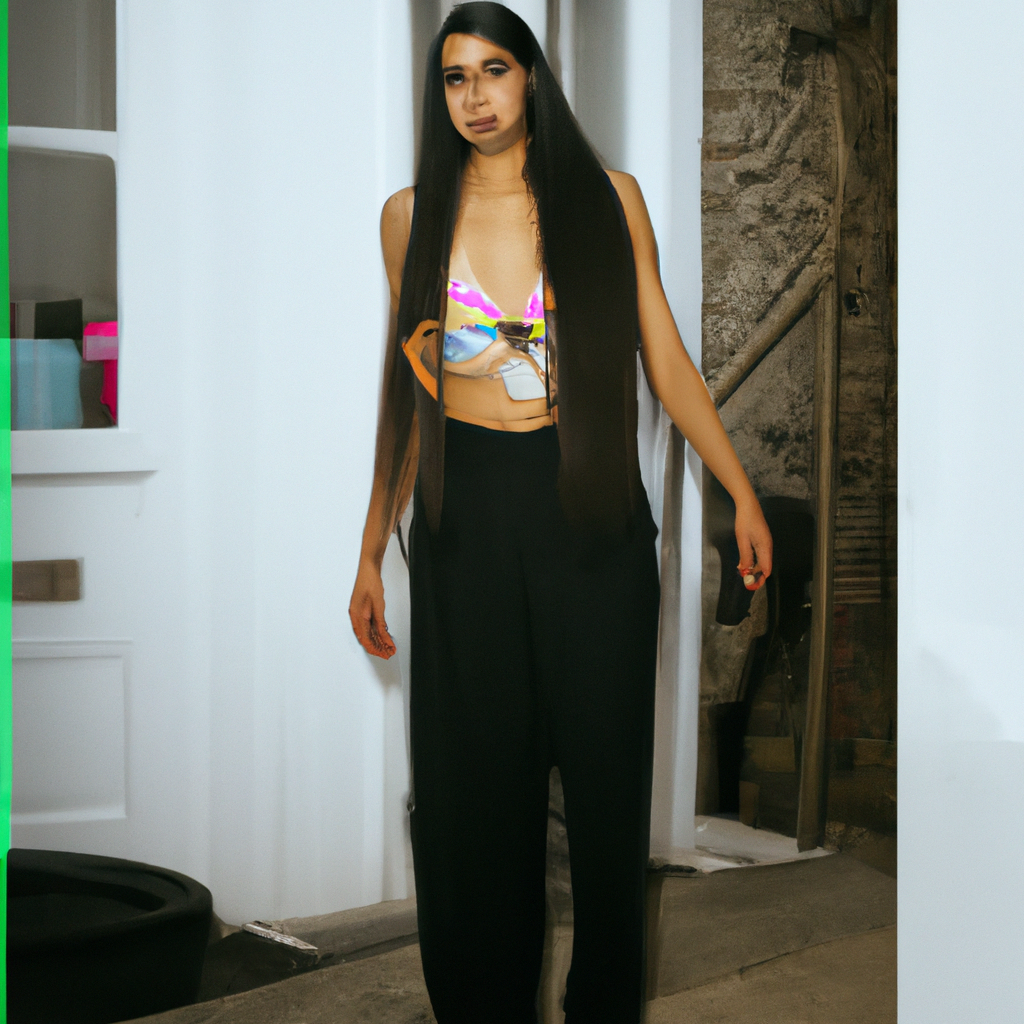
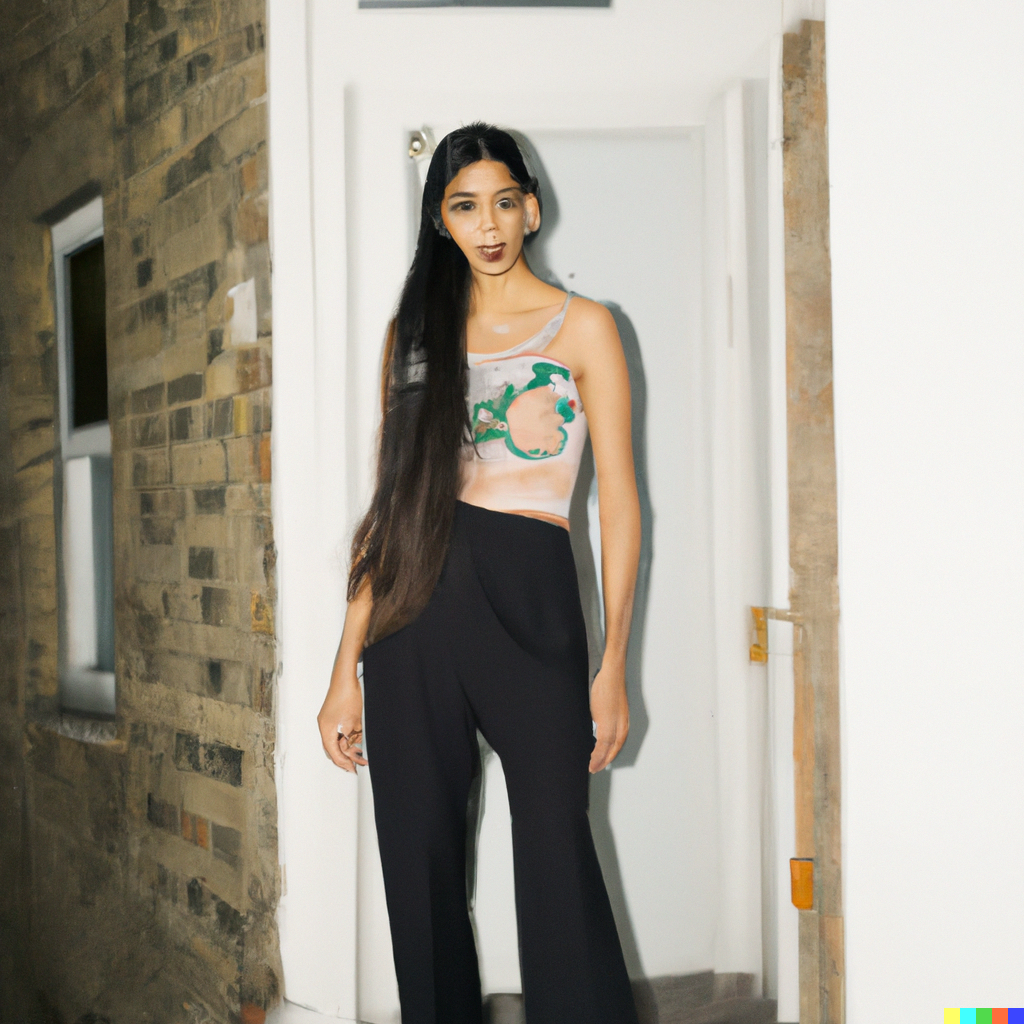
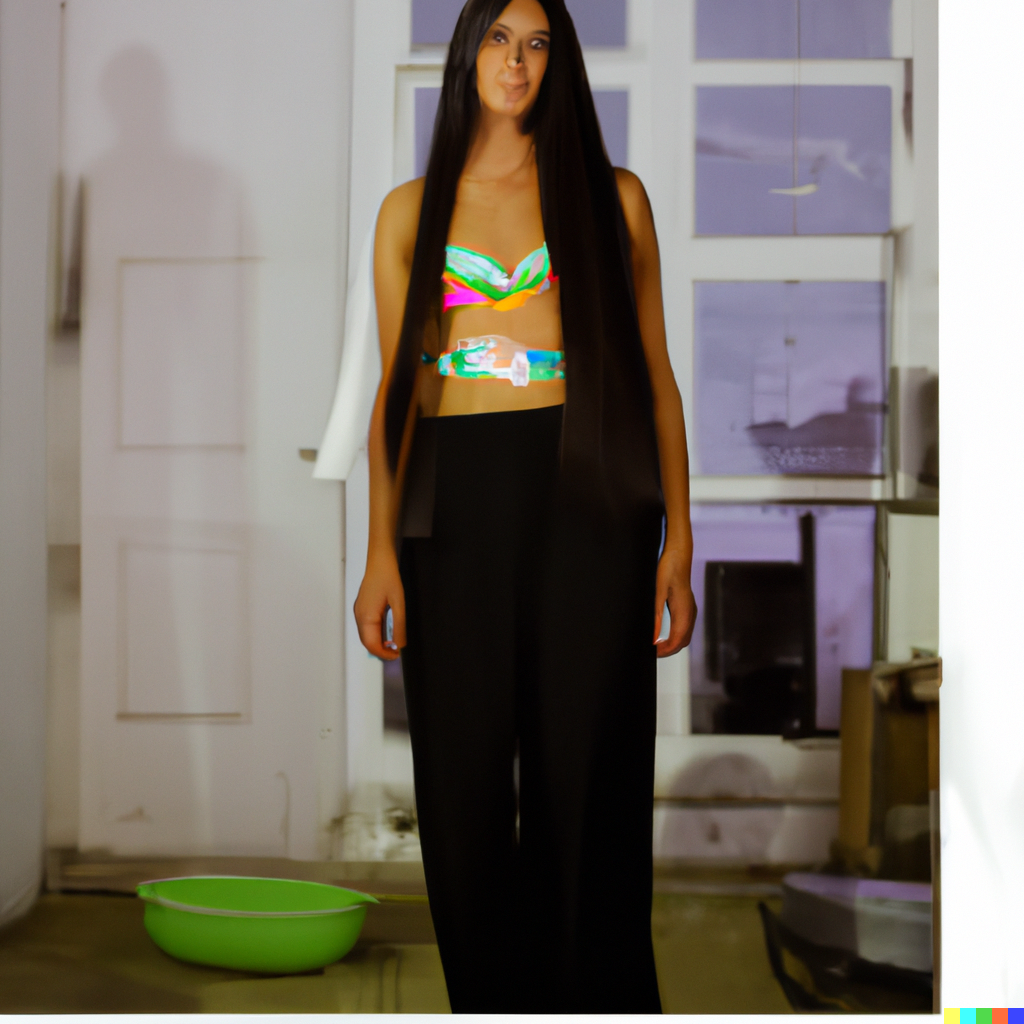
29/11/22’ Learning to use the CNC with George and how to produce simple vector drawings to instruct the router.
There are various cutters one can use and lots of possibilities in terms of depth, but to start the act of tracing a photograph to produce a simple line drawing was inspiring. Again, there is an act of translation at play, or variant making which interests me. I start with a photograph from an auction catalogue which is a translation, so now we are bypassing the actual object itself and, in this context, it becomes almost redundant.
I copy the image, tracing it with a series of line and box tools in illustrator (There are two basic modes of cutting which are lines and pockets, a line is cut with the width of the selected router head and a pocket cuts out all the space between connected lines, used for cutting areas larger than the router head). As I go through this process, I simplify some elements, the photograph now being translated into a series of 2D lines. Once this is done adjustments are made for depth, router passes etc., and the instructions are input to the router.
From a photograph the symbol is now manifest in wood, as it is routed it becomes part of the tactile world, adorned with physical coat hooks and now becoming an object capable of hanging clothes. There is an interesting cycle at play here from photograph to drawing and into material form. It is like a sort of backwards birth in which we end up with an object that seems to sit between dimensions. Naming it logically as an ‘Art Deco Wrought iron hall tree’ It gives me the same impression as an A.I variation... it is what it says it is, but it also is not.
03/12/22’ Knitting machines and img2track.
I have been to some workshops on knitting machines and img2track software in the Camberwell Graphic design space. I have learned that code for knitting machines was essentially the birth of binary, and that this is what the first computers where used for.
There are a lot of interesting projects which pay homage to this connection between knitting and computer technology, with a lot of artists making interesting generative works in which conversions and translations take place - from recording the motion of the sea, to translating musical scores. In a similar way to using an analogue camera or the CNC router, I find that I am inspired to use methods of translation. It is the act of translating from one form to another... producing a variation which excites me. It reminds me of when I first started to use photoshop in college and I spent hours applying all the pre-set filters to images until nothing was left and my images resembled more a digital glitch or abstract painting than a photograph.
I have been inducted onto the machine and plan on making more experiments with this in the future (most likely in Unit 2). There is something brilliantly simple about these conversions that can take place, or more it is the ability to simplify vast movements such as a musical score, into a list of 1’s and 0’s.
I have made designs for an initial hanging which could be caught in the same sort of space that 80’s Sci-fi novels are today... something like future nostalgia. the idea is for a commemorative hanging of a stylised retro-futurist soldier going off to war... his costumed portrait in the centre, bordered with best wishes and his name which is a gamer tag. I have spoken with a textile designer friend in New York who will collaborate with me on this project to incorporate different knitting techniques. The idea is that I produce the centre portrait using img2track and 90’s video game imagery, while she uses a manual jacquard technique to produce and LCD screen inspired wrapping text border. The two elements will be hand sewn together.


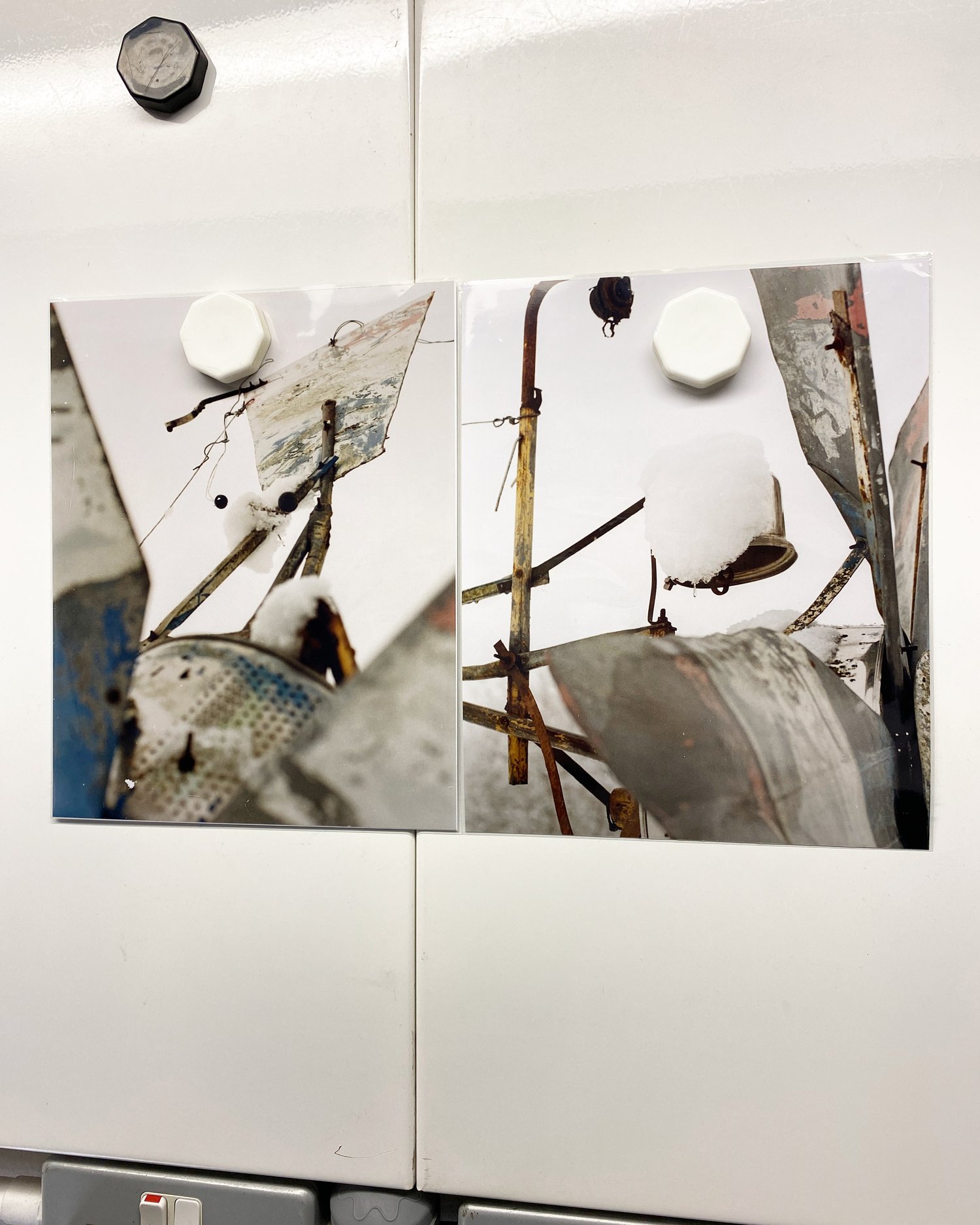


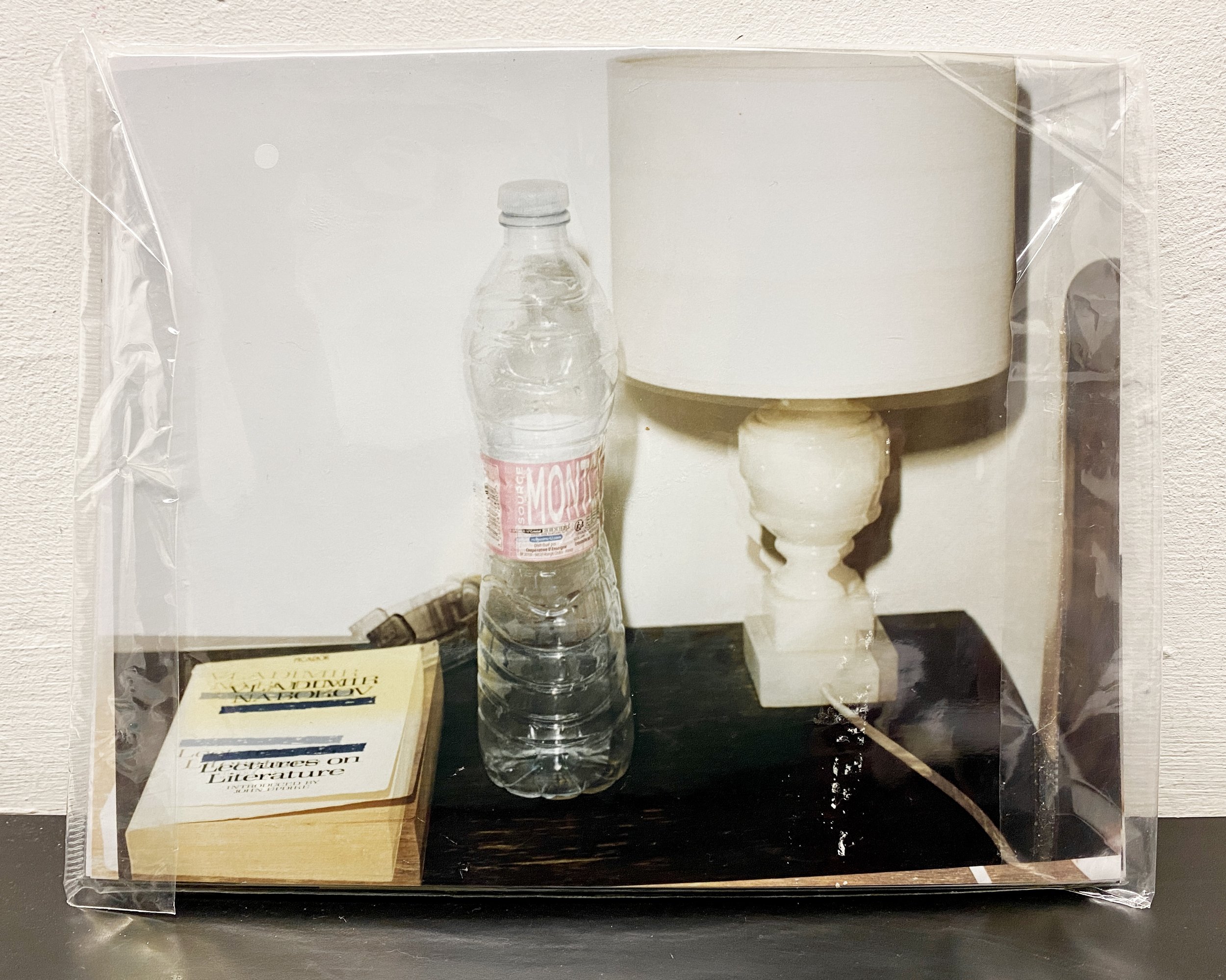
25/10/22’ Avatars
Starting to work with recently found materials, I am drawn to using these early millennium toys - all of which are being thrown out by neighbours presumably as their children become more interested in iPads and virtual reality. The toys I have selected either represent past or future heroes, in the forms of knights and cyborgs respectively.
These heroes / or avatars, for my generation, where our first encounters with idolism. Through figures such as these we were invited to play with characters of strength and bravery who seem to deliver a specific westernised narrative both in terms of our past roots and conflicts (the Minitour/ beast, the spear wielding soldier, the sword wielding knight) as well as suggestive futures, what we can be as we progress into the future, and how can we use these new technologies (the Power-ranger/ cyborg).
Between these figures we find our-self caught again in the present. Not just in the static created between specific pasts and futures delivered to us, but also in the fact that these toys remain as ruins of pre-digital childhood. There are now faster, and more exciting ways to indoctrinate ourselves. We now perpetuate our own narratives online and can even become the avatars ourselves. The fruit has been born from the seed of plastic toys.
In fantasy/ sci-fi RPGs such as the Oblivion and Fallout video-game series (spanning from late 1990’s to present day), one can expect options in character customisation such as armour, species, physical skills, mental attributes, as well as the ability to balance receptivity to metaphysical phenomenon such as luck, all within a finite/ pre-determined list of possibilities. These choices made will be effectual in game play, often suiting a character to specific side quests, and helping to form different evolving narratives. Contemplating this aspect of world building, I am in the process of assembling these toys - many missing parts (hands, heads, weapons) - alongside a deck of incomplete new-age spiritual cards. The cards have prompts such as ‘swiftness’, ‘strength’, ‘completion’, ‘strife’, ‘interference’ - they become perhaps selected/ perhaps selectable character traits. The avatar sits in stasis alongside its totem card/ cards, guided by a prophecy of which we can’t tell is self-driven or imposed.
Donna Haraway’s ‘Cyborg Manifesto’ is now on my reading list.


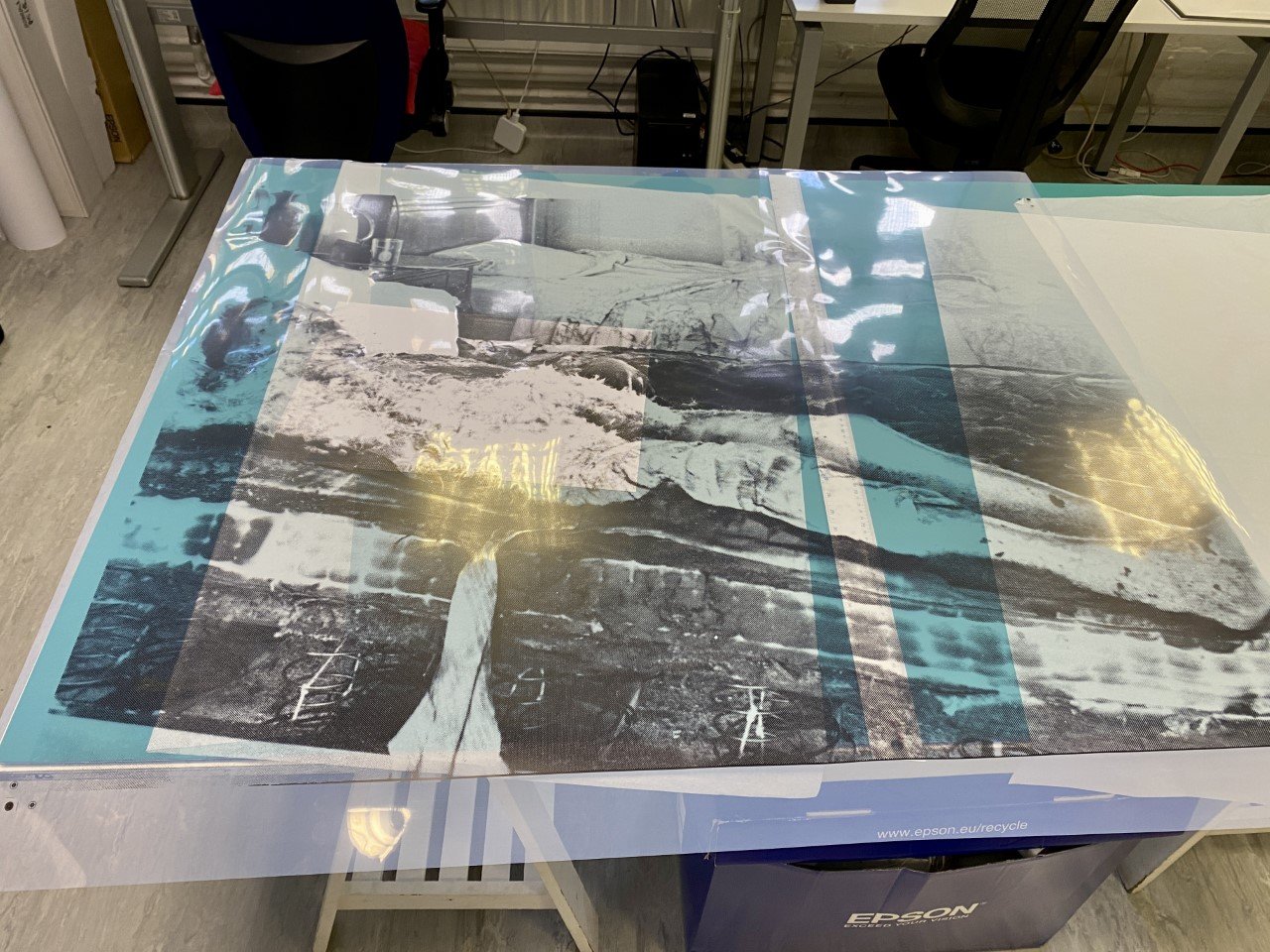
09/11/22’ PVP/ Player Vs Player
Starting to make tests in the Camberwell studio space, I have been bringing gathered materials together, including several boxed PC games for windows 95 and a small model of a medieval fortress. These games are mostly flight simulators for war planes and helicopters, and I have been selecting elements of the language, packaging and visual catalogues included with these games to produce assemblages. As materials gathering is a big part of my practice, periods of time culminate in these mini crescendos in which enough material has been gathered to start producing works. This process of foraging and nest building becomes seasonal in a way, coming in waves. There is no official start or end point, but it depends on time, space, money, all that which builds the architecture within which i am able to create.
Creating different shiftable structures (such as an acrylic frame held together with clips, a repainted sideboard, or glass leaning against a wall) part of my experimentation has been swapping around materials within these structures and testing how certain expressions behave towards each-other. A structure may then morph around a work, or a work around a structure (It is all work as it comes together but i find it useful to play with these divisions in the work). My technique has been starting with certain structures in the space - such as an un-made frame leant against a wall - and then performing with different inputs into these structures in order to discover what structure supports what work etc. In this way the work informs the structure and vice versa. I feel there is something is this process that echoes working within any system, it is in this vein for example that I am drawn to the work of Leonid Sokov - making work between the USA and USSR (2 larger structures).
Something about limitation provokes experimentation, and this is an energy that I find essential in making work. Everything tends to be made in some sort of rebellion, usually in subtle forms, and often inverse rebellions are made in which division is disguised as multiplication. What I am trying to express as this work evolves is some sort of information battle, the battle of past and future/ fiction and reality/ known and un-known. A play is emerging between the constructed and the deconstructed, that which is malleable and that which is set in stone. In part this is a response to a recent seminar and further reading on A.I diffusion models, and the de-noising selection process trained into A.I which enables it to create variations of images while retaining their essential character.
Peers have also recently picked up on a long-term theme of my work which is the domestic. I have sort of been reminded of this element, which has become so mainstay in my work, through conversations and I am now contemplating how make further plays into this. One example experimenting more with textiles, and I am looking into using digital knitting machines to possibly translate some imagery through.




21/11/22’ Working with dall-e-2 A.I Image tool. Denoising diffusion implicit models.
Fillowing a seminar with Duncan, I have been reading one of the research papers that OpenAI put out, titled ‘Hierarchical Text-Conditional Image Generation with CLIP Latents’. It describes the Denoising Diffusion Implicit Models (DDIM) used in creating image variants, explaining it as a conditioned learning process in which the A.I is trained to read data as ‘essential’ and ‘non-essential’. Based on this it can decide what to change, what to keep the same, and thus how to produce a variant that is different but holds the essential character of the original image. In the context of Art practice this is an exciting train of thought as it kind of mimics the infinite character of creating. We can think of ourselves as A.I, (we are artificial intelligence) as what they have been trained to do is mimic and simplify our own cognitive processes.
I don’t remember what her name was, but I remember an interview i watched in which a painter said something like... Painting is just a sequence of decision making, and once you stop making decisions the painting is finished.
We can think of the collection of certain materials in an art context as a storing of certain information/ prompts, which we feed to ourselves as we would an A.I... something strong, something soft, something rough, something from the past, something which looks to the future. Oil paint, acrylic, mud, hands, feet...
What’s next is just making variations as to how they may come together. Decisions made on what remains relevant and what doesn’t seem to come from some ethereal place, maybe subconscious, maybe metaphysical... but is this not how an A.I would interpret its own input instructions?
Really it makes you think about just how trained we are, and just how much freedom of thought we actually have. It’s a reminder, but i feel this anxiety is at the core of my work, and is maybe why I shift so much, run away from technique, and keep things just outside of my own reach... it seems like the closest thing to freedom.
I enjoy using dall-e-2, especially inputting finished works to see variations, not just representative of where the works could have gone on quantum mechanics level, but actually standing before us as alternate planes. Every variation is a new dimension... and it may be interesting for this to become a process in a longer chain of working and responding. Another thing that was interesting was re inputting-the A. I’s own variations. As you can see in the selection of 3 images above the variations have eventually taken us through the closed door of the original image, inside to previously non-existent room.


